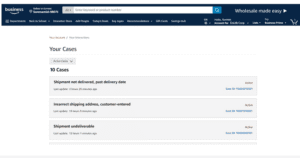The pandemic thrust many businesses further into B2B ecommerce and, as a result, e-procurement. That has led more businesses to engage in e-procurement to manage corporate spending—including the approval and storage of purchase orders and invoices, expense management, vetted suppliers, and online tools for guided purchasing and quick re-ordering of supplies.
Now, businesses are looking at ways to make e-procurement more efficient. So how do small- to mid-size businesses and Fortune 100 companies find the technologies that will help ease the purchasing process? That’s where Aster Angagaw at Amazon Business hopes to alleviate the pain points of the B2B procurement process.
E-procurement is an expanding area
Angagaw, who began working at Amazon Business early in 2022 as vice president, commercial, public and strategic sectors, serves organizations earning above $25 million in revenue. Her role is solving procurement problems for SMBs through Fortune 100 companies, she says. She is also author of the book: “We Are So Much More: Integrating the 7 Dimensions of Success for Women Leaders to Thrive at Work and in Life,” published in 2021.
The procurement process often includes multiple people and teams evaluating and deciding on their required product details and price ranges to purchase needed supplies. This can involve a lot of back-and-forth communication between sellers and purchasers. Angagaw says Amazon Business is creating a marketplace where sellers can use technology to dynamically change pricing based on the buyer interest.
E-procurement is an expanding area. According to a projection from Digital Commerce 360, transactions placed through e-procurement software are on track to increased 17.0% year over year in 2021 to $934 billion, accounting for 8.5% of all B2B electronic sales, and is on track to surpass $1 trillion in 2022. But e-procurement also involves B2B purchasing directly on ecommerce sites and marketplaces.
Many businesses that rushed to establish an ecommerce presence during the pandemic are now investing for the long term. In the “B2B E-Commerce in Evolution Report,” which Amazon Business published in June 2021, 85% of business buyers said their organization pushed more of its procurement online as a result of COVID-19. And 50% said they have more fully digitized their purchasing processes.
“B2B e-procurement is an area that is ripe for transformation,” Angagaw says.
An easier B2B e-procurement process
Angagaw has experience in the B2B commerce environment, having served as president of ServiceMaster Brands, a franchise services division of ServiceMaster Global Holdings Inc.
ServiceMaster’s core services include disaster response and restoration, janitorial services, professional home cleaning, furniture repair and home inspections. She also held executive roles at Sodexo SA, a Paris-headquartered multinational diversified food services and facilities company with 440,000 employees and over $20 billion in revenue.
Angagaw credits working with franchisers and franchisees as one reason she has the qualifications to help businesses digitize their procurement processes. “By definition, these are small businesses,” she says.
She adds that working through COVID-19 proved particularly challenging as accessing personal protective equipment (PPE) was difficult. In addition, it was complicated finding replacements for out-of-stock products, vetting quality, and ensuring timely delivery. These challenges prepared her for her latest role, she says.
“I understand the need to make the buying and selling process easier for businesses,” she says. “I’m excited to learn how to leverage machine learning and sophisticated technology to ease that experience.”
Access to resources
Amazon Business aims to help by letting small- and mid-size businesses access Amazon’s expansive network of buyers and vetted sellers. Amazon vets vendors to ensure their products meet quality standards.

Aster Angagaw, Amazon Business
Part of Amazon’s small-business initiatives include promoting diversity, including Black-owned, women-owned, and veteran-owned businesses, among others. Amazon Business sends teams to recruit and work directly with these businesses to help transition their move onto the marketplace.
Over the last few years, Amazon has worked with organizations to improve their purchasing process. In 2017, for example, it helped Johns Hopkins University streamline its purchasing of supplies from local businesses. These businesses are vetted by Amazon and are considered credentialed suppliers.
“The university was using more than 1,000 separate vendors,” Angagaw says. “Of those, the college spent less than $1,000 per year for 80% of those vendors. That’s very costly to manage.”
Angagaw says Amazon Business provides businesses with guided buying tools designed to curate product selections for their employees.
“We can create a customized space for their employers or administrators to buy from them and have visibility of those purchases,” she says. “They can then glean their insights to make informed decisions instead of using a disorganized system.”
Businesses want to invest in new tools to improve the digital experience. According to Amazon’s “B2B E-Commerce in Evolution Report,” 60% of respondents plan to invest in digital/online invoices. 56% plan to invest in the automation of manual procurement processes (e.g. purchase approvals). And 42% cited voice technology, such as voice ordering using a virtual assistant. These stood as the top three procurement technologies buyers’ organizations plan to invest in the next five years.
Sellers want to use technology to meet new buyers without having the scale of operations larger organizations may have.
Amazon introduces technologies to improve operations
Over the last year, Amazon Business has launched several buyer applications designed to make its marketplace a “one-stop-location” — particularly for small to midsize businesses. In August, the company launched “Your Interactions,” a tool that allows customers to monitor procurement progress and stay organized. Customers create tickets they can update, close, re-open and reference for later use.

Amazon Business’ “Your Interactions” tool is designed to keep procurement progress updates and open support issues in one place. Users can track and reference historical data. They can also receive notifications of issue updates in real time. This is instead manually following up via live chat or by phone.
In July, Amazon Business launched a program offering $20,000 grants to small businesses for innovative sustainability products. The Amazon Launchpad program assists sellers with certifications and product placement in efforts to provide customers with more climate-friendly products.
A month earlier, Amazon Business rolled out its Custom Quote tool, letting buyers request a discounted price on high-volume purchases that are more than $10,000 or over 999 units.
In January 2022, it launched Amazon Business Punch-in, an online tool that allows companies to manage their buyers’ spending even when they do not start a purchase through an e-procurement software system.
And between September 12 and 18, it kicked off a Deals Week for small-business customers. These businesses have access to discounted pricing from Amazon Business on items such as PCs, office supplies, furniture items and some devices. The move is part of the company’s Small Business Month.
SMBs ramp up networks
The ongoing changes and technologies are part of what Angagaw says will help make a difference for companies, particularly SMBs, looking to expand.
While the purchasing process is fundamental to B2B, Amazon also focuses sharply on sustainability and social matters, Angagaw says.
“Although improving efficiency remains the top priority, about 40% of our priorities lie with sustainability and social responsibility efforts,” she says.
Angagaw says Amazon Business is working to increase diversity among its suppliers.
“And making sure that we can facilitate the buying and selling with small, local, diverse sellers to businesses,” she says. “It can be difficult for businesses to find smaller suppliers.”
Amazon Business has a program that provides 14 certifications that allow smaller businesses to sell on the platform and then aggregate sales under multiple certifications for customers.
“What’s excited me, really,” she says, “is the idea of being able to work with a lot of businesses or sellers and scale them to the level where they can sell to Fortune 500 companies. That’s a very exciting, purpose-driven opportunity for me.”
Sign up
Sign up for a complimentary subscription to Digital Commerce 360 B2B News, published 4x/week. It covers technology and business trends in the growing B2B ecommerce industry. Contact senior editor Gretchen Salois at [email protected].
Follow us on LinkedIn and be the first to know when new Digital Commerce 360 B2B News content is published.
Favorite